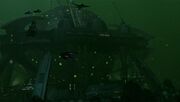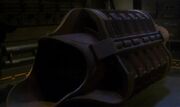A Xindi-Aquatic female (2153)
A Xindi-Aquatic male (2153)
- "It is easier to count the stars in the sky, than for an Aquatic to come to a decision."
- - Degra (ENT: "The Council")
The Xindi Aquatics were a non-humanoid race that evolved to living underwater. They were one of the six original species of Xindi, with whom they shared a common genetic ancestry.
Overview
The Aquatics were complicated and enigmatic and were known to over-analyze, taking an excruciatingly long period of time to come to decisions; they once took six days just to agree to attend a specific meeting of the Council. However, the Aquatics' prudence was at times what kept the Council from breaking apart, which is why Degra had them build the weapon. (ENT: "Countdown")
They responded better to visual stimuli and were extremely suspicious of the spoken word. They admired boldness and confidence and treated hushed tones with suspicion.
In 2154, one of their representatives to the Xindi Council was Kiaphet Amman'sor, a member of the extremely wealthy Ibix Dynasty. She wielded considerable power within the Xindi hierarchy. (ENT: "The Council")
Physiology
The Aquatic females were larger and had rougher skin than the males who were more slim and had smoother skin. Females had a more humanoid-looking face, whereas male faces were rounder.
The two Aquatic Councilors (2153)
They had slit-like irises in their eyes and were capable of seeing far better, underwater, than humanoids were. Aquatics had three fingers on each forelimb, ending in short fingernail-like claws, with webbing in-between for easier swimming. Their skin was a greenish shade and had blotches of olive. Like all Xindi, they had a fold at the top of their cheekbone. They had tails for maneuverability and their hind limbs were fins.
Language
Xindi-Aquatic communication was highly complex and, since the Aquatics were underwater beings, they did not use their mouths. When using the past tense, they switched to SONAR. (ENT: "The Council")
Aquatics learned the Human language in 2154 in order to communicate with that species. (ENT: "Countdown")
History
During the Great Diaspora in the 2030s, the different Xindi species engaged in a civil war that ended with the destruction of their homeworld. The Xindi-Aquatics, like all the Xindi, had to colonize other worlds in order to survive. Thanks to the Guardians, they were able to find habitable worlds. The Xindi were then taught to think of the Guardians as god-like beings.

The Aquatics build the Xindi weapon
In the 2140s, the Guardians warned the Xindi Council that, unless they destroyed Earth, the Humans there would destroy their future homeworld. The Aquatics were originally against the building of a superweapon; however, they changed their minds after the Guardians presented a visual record of their future world's destruction. They eventually agreed to create it and were assigned to build the Xindi weapon, because they were the most level-headed and efficient. The weapon was built underwater on Azati Prime. (ENT: "Stratagem", "Azati Prime")
In late 2152, they agreed to the launch of a miniature prototype weapon, which killed seven million people on Earth. This led to the Humans sending the Enterprise NX-01 into the Expanse to stop the weapon. Throughout the following year, the Council monitored their advancement, as the Reptilians and Insectoids suggested alternate ways of exterminating the Humans. At the Council meetings, the Aquatic councillors were often the more balanced and level-minded members, suggesting that they continue monitoring them instead of sending a fleet to destroy them right away. (ENT: "The Expanse", "The Xindi")
In 2153, after finding the location of the weapon, Captain Jonathan Archer, of the Earth ship Enterprise, tried to use the Insectoid shuttle to get into the weapon and destroy it, but was captured before he could do so. While he was away, the Xindi-Reptilians and Insectoids opened fire on Enterprise, nearly destroying it. (ENT: "Azati Prime")

Captain Archer, retrieved in an Aquatic escape pod
Degra didn't trust Captain Archer, but couldn't let go of the possibility that he was telling the truth. In early 2154, after the Xindi Council ordered the Reptilians to cease their attack on Enterprise, Degra had the Aquatics, the only ones he could trust, transport Archer back to Enterprise. After he briefly regained consciousness aboard their vessel, he was put in an escape pod and left adrift for Enterprise to find. (ENT: "Damage")
The Aquatics finally decided to help the Humans, when Enterprise promised to destroy the Sphere network. As a result, the Aquatics sent several of their ships with Enterprise, the Arboreals and the Primates, in their concerted effort to fight the Reptilians and the Insectoids.
Ultimately, most of their fleet was defeated when the Sphere Builders triggered the spheres to create massive anomalies, which breached the hulls of the Aquatic ships, releasing water into space. (ENT: "Countdown", "Zero Hour")
Technology

A Xindi-Aquatic cruiser
The Xindi-Aquatic ships were the most powerful and largest of the Xindi races, but compared to Primate and Insectoid ships, they were among the slowest and least maneuverable. Aquatic starships had to have every compartment filled with water for its crew. However, there was at least one room that could be used to house a humanoid and filled with breathable air, and that had a window to water for Aquatics to talk with them. (ENT: "Damage")
The largest of their cruisers resembled huge Terran manta rays and were large enough to comfortably accommodate an Template:ShipClass vessel in its aft cargo hold. They were extremely powerful in comparison to those of other Xindi, destroying several Reptilian and Insectoid ships with ease at the final battle against the Xindi superweapon. It was only because of the immense anomaly field that they were disabled.
The Aquatics were the inventors of the biometric hologram, which was used to train Xindi surgeons. The Xindi Council chambers were also fit with biometric holograms, as they were used to project viewscreens and images of Human physiology for use in the creation of a bioweapon, as attained by Rajiin. (ENT: "Rajiin", "The Council")
Starship classes
| Xindi species |
|---|
| Aquatic • Arboreal • Avian • Insectoid • Primate • Reptilian |
Appendices
Appearances
- ENT:
- "The Xindi"
- "Rajiin"
- "Proving Ground"
- "Damage"
- "The Council"
- "Countdown"
Background
When executive producers Rick Berman and Brannon Braga were deciding on which species should comprise the Xindi, they found selecting aquatics to be an easy choice. According to Braga, this was "because–just thinking about Earth–you can imagine sea mammals possibly evolving to a higher intelligence." The executive producers also decided that the Xindi-Aquatics, like the Xindi-Insectoids, would be computer-generated characters and behave in a certain manner. Eden FX CGI animator Sean Scott noted, "They [producers] were very insistent that the Aquatics didn't 'act' so much as that they 'spoke and floated.'" (Star Trek: Communicator issue 149, pp. 50 & 52)
Design evolution (clockwise) in concept sketches
Instrumental to the design process was some conceptual artwork created by visual effects producer Dan Curry. "I first did some sketches that looked like a cross between a mermaid and the 'Creature from the Black Lagoon,'" he explained. After receiving some constructive feedback on these illustrations from Berman and Braga, Curry proceeded with the design, taking inspiration from wildlife. "I went back, looked at different sea creatures and was inspired by an aquatic reptile called a 'mosasaurus.' But instead of having it be four-flippered–and knowing that our alien aquatics have a technological culture, which means they must have hands, opposable thumbs and manipulate machines–I took a mosasaurus body from the armpits down, changed the tail structure somewhat and the rear flukes, and gave it arms–but arms more like a whale fluke for swim and guidance, assuming propulsion would be primarily from its tail. And then we gave it more of a Xindi face–more smooth in a way, partway between a whale and a reptile." (Star Trek: Communicator issue 149, p. 52)
Finding an effective means to portray the Aquatics talking turned out to be a challenge. "We had to have it where they would talk, but we didn't want a mouth that would open and close: we felt it would look silly underwater," recalled Curry. "So [supervising producer] Peter Lauritson had the idea that we would make the gill area behind the cheeks expand and contract, as if somehow it could force water through membranes the way hadrosaurus would force air through their crests, or the way certain species of frog will use their throats to generate sound." (Star Trek: Communicator issue 149, p. 52)
It was Sean Scott who modeled the Xindi-Aquatics, with additional assistance from Eden FX supervising CGI animator David Morton. [1] The latter visual effects artist textured both genders of the Aquatics. Morton mainly looked at dinosaurs while doing so, but also took cues by studying the makeup for the Xindi-Reptilians. "We tried to keep a lot of the shadowing, the detail and the wrinkling around the eyes," stated Morton. Sean Scott animated the CGI model for the female Aquatic. Of the male equivalent, Morton said, "I didn't want the male to look like a 'happy turtle,' but he didn't need to be too scary: I just wanted a sense of giving him some timeless age–and a bit of an orangutan look around the face, even though he's a lizard." (Star Trek: Communicator issue 149, p. 52)
Executive producer Brannon Braga was happy with the depictions of the Aquatics, stating, "I liked the way we used the Xindi-Aquatics." (Star Trek Magazine issue 117, p. 62) Braga also once joked that, instead of having had the Xindi-Primates befriend the Enterprise crew, "it's kind of a shame" that the Starfleet officers "couldn't befriend the fish people." However, he then went on to say, "That would have been too expensive." ("The Xindi Saga Begins", ENT Season 3 DVD special features) Braga was also impressed with the Xindi-Aquatic cruiser. (Star Trek Magazine issue 117, p. 62)
Apocrypha
In the chronology set out by the Pocket Books' series of Enterprise novels, the Xindi-Aquatic species was not the first aquatic species which was depicted as peacefully co-inhabiting a planet with another species and being encountered by the NX-class Enterprise. In the novel By the Book (set in 2151), Enterprise encounters a water-faring alien race called the Hipon (Hipon at Memory Beta, the wiki for licensed Star Trek works) that share a planet (Fazi (planet) at Memory Beta, the wiki for licensed Star Trek works) with a species known as the Fazi (Fazi at Memory Beta, the wiki for licensed Star Trek works).
In the novelization of "The Expanse" and "The Xindi" (entitled The Expanse), the Aquatics are referred to as having been the first, from an evolutionary perspective, of the Xindi to have gained intelligence. The book also states that their development as a relatively peaceable society was a result of not being land-based.
